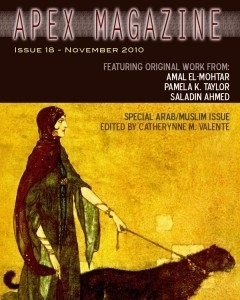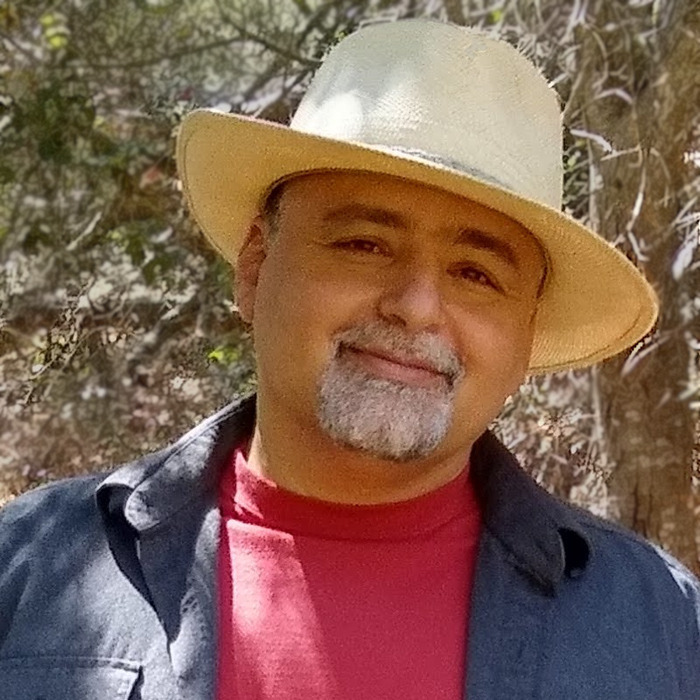
Part of Series
We are proud to present an all Arab/Muslim themed issue. Fiction: “The Green Book” by Amal El-Mohtar “50 Fatwas for the Virtuous Vampire” by Pamela K. Taylor “The Faithful Soldier, Prompted” by Saladin Ahmed “Kamer-taj, the Moon-horse” from Forty-four Turkish Fairy Tales collected by Dr. Ignácz Kúnos, 1913 Poetry: “Me and Rumi’s Ghost” by Samer Rabadi “Tur Disaala” by Abdul Jawad Elhusuni “Al Manara Dirge” by Sara Saab
Authors

Saladin Ahmed was born in Detroit and raised in a working-class, Arab American enclave in Dearborn, MI. His short stories have been nominated for the Nebula and Campbell awards, and have appeared in Year's Best Fantasy and numerous other magazines, anthologies, and podcasts, as well as being translated into five foreign languages. He is represented by Jennifer Jackson of the Donald Maass Literary Agency. THRONE OF THE CRESCENT MOON is his first novel. Saladin lives near Detroit with his wife and twin children.
Ignác Kúnos was a Hungarian linguist, turkologist, folklorist, a correspondent member of the Hungarian Academy of Sciences. Ignác Kúnos (22 Ekim 1860 – 12 Ocak 1945), Türk dili, halk edebiyatı ve halkbilimi üzerine yapıtlarıyla tanınmış Macar Türkolog. Kúnos Ignác vagy Kunos Ignác, 1881-ig Lusztig Ignác (Hajdúsámson, 1860. szeptember 22. – Budapest, 1945. január 12.) nyelvész, turkológus, folklorista, a Magyar Tudományos Akadémia levelező (1893) tagja. At his time he was one of the most recognised scholars of the Turkish folk literature and Turkish dialectology. Grandfather of George Kunos (1942) American-Hungarian neuroendocrinologist, pharmacologist. He attended the Reformed College in Debrecen, then studied linguistics at the Budapest University between 1879 and 1882. With the financial support of the Hungarian Academy of Sciences and the Budapest Jewish community he spent five years in Constantinople studying Turkish language and culture. In 1890 he was appointed at the Budapest University as professor of the Turkish philology. Between 1899-1919 he was the director of the newly organized Oriental College of Commerce in Budapest. From 1919 until 1922 he held the same post at the Oriental Institute integrated into the Budapest University of Economics, and then from 1922 he taught Turkish linguistic at the university. In the summer of 1925 and 1926, invited by the Turkish government, he was professor at the Ankara and Istanbul Universities, besides this in 1925 he organized the Department of Folkloristics at the Istanbul University. He died during the soviet siege of Budapest. Ignác Kúnos (22 Ekim 1860 – 12 Ocak 1945), Türk dili, halk edebiyatı ve halkbilimi üzerine yapıtlarıyla tanınmış Macar Türkolog. Kúnos, Türk halk edebiyatının Batı ülkelerine tanıtılmasında öncü olmuştur. İlk ve orta öğrenimini Debrecen'de yaptı. Üniversiteyi Budapeşte'de bitirdi. Öğrencilik yıllarında Macar halk diline ve kültürüne ilgi gösterdi; Hungaristik alanında çalışmalar yaptı. Daha sonra Türkçe öğrendi ve Ármin Vámbéry, Josef Budenz ve Bernát Munkácsi gibi ünlü türkologların derslerini izledi. 1885'te bir süre Bulgaristan'daki Türkler arasında yaşadıktan (1885) sonra Anadolu'da beş yıl süren bir araştırma gezisine çıktı. Bu sırada Macar Bilimler Akademisi'ne gönderdiği veriler, bilim çevrelerinde ilgiyle karşılandı. 1890'da Macaristan'a döndü. Gezi boyunca derlediği türküleri, halk masalları ve öykülerini, ayrıca Karagöz, ortaoyunu, Nasreddin Hoca ve bazı geleneklere ilişkin notlarını yayımlayarak kısa sürede Türk halkbilimi alanındaki en ünlü adlardan biri oldu. Rumeli ve Anadolu Türkleri arasındaki farklılıkları da yansıtarak tanıttığı Türk dili ve edebiyatı ürünlerinden bir bölümü, Vasili Radlof'un 10 ciltlik Proben der Volkslitteratur der türkischen Stämme (1866-1907; Türk Kavimlerinin Halk Edebiyatından Örnekler) adlı yapıtının 8. cildi (1899) içinde yayımlandı. 1925-26'da Türk hükümetinin çağrılısı olarak Ankara ve İstanbul'a gitti ve konferanslar verdi. Bernát Munkácsi ile birlikte, dönemin önde gelen Türkoloji yayınlarından Keleti Szemle dergisini yönetti. Macar Bilimler Akademisi, Uluslararası Orta ve Doğu Asya Derneği, Paris'teki Asya Derneği gibi kuruluşların da üyesiydi. Kúnos Ignác vagy Kunos Ignác, 1881-ig Lusztig Ignác (Hajdúsámson, 1860. szeptember 22. – Budapest, 1945. január 12.) nyelvész, turkológus, folklorista, a Magyar Tudományos Akadémia levelező (1893) tagja. Addig egyedülálló terjedelmű és úttörő jellegű török népköltészeti gyűjtéseinek – és legfőképp a török népmesekincs feltárásának – köszönhetően korának európai szinten legelismertebb turkológusai közé tartozott, elévülhetetlen érdeme a török népköltészeti alkotások be bevonása az európai szövegfolklorisztikai kutatásokba. Számottevő eredményeket ért el a török nyelvészet és dialektológia területén, fél évszázadon keresztül volt a budapesti tudományegyetemen a török filológia tanára.



